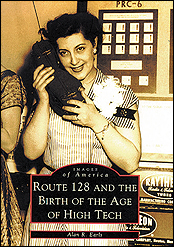12/29/2003:  Urban Archaeology
Urban Archaeology
Road to Nowhere
or, What To Get Santa26 for The X-mas Gift You Forgot
from Milford Daily News
Alan Earls grew up in Waltham and Wayland and his father worked for a company just off Rte. 128.
"I say I grew up in the shadow of 128," he joked. "When I was young, everybody was zipping along in the Cadillacs with the tail fin. That highway was the future."
That highway turned out to be a large part of Earls' future. As state officials begin work to expand Rte. 128, the Franklin resident has published his first book, "Route 128 and the Birth of the Age of High Tech."
More
DEDHAM -- Alan Earls grew up in Waltham and Wayland and his father worked for a company just off Rte. 128."I say I grew up in the shadow of 128," he joked. "When I was young, everybody was zipping along in the Cadillacs with the tail fin. That highway was the future."
That highway turned out to be a large part of Earls' future. As state officials begin work to expand Rte. 128, the Franklin resident has published his first book, "Route 128 and the Birth of the Age of High Tech."
"The highways can really define a region," said Earls, former editor of Mass High Tech, a weekly journal covering, among other things, the Rte. 128 technology phenomenon. "Businesses, then employees, set up around transportation."
After culling years of research and interviews, and time spent organizing hundreds of photos of the highway, Earls put together his book in six months.
"It's something I've always wanted to do," said Earls, now a freelance writer. "This is something I know about."
State Rte. 128, first proposed in the beginning of the 20th century and built beginning in 1949, was often referred to as "The Road to Nowhere."
"The idea of a circumferential highway was new. This was the first beltway around a major city," Earls said. "To have it loop through cornfields outside of Boston didn't make a lot of sense."
That all changed after World War II, when companies like Raytheon and Polaroid set up shop along the highway.
Sections of the 65-mile highway were widened in the 1960s, but suburban development along the highway would draw even more cars to the area. By 1986, state highway officials had to ask the federal government for a waiver to allow use of the breakdown lane on the southern half of the highway during morning and evening rush hours.
The Road to Nowhere will be widened again as the Rte. 128 Add-A-Lane project kicks into full swing over the next few years. Work has begun on sections near the Dedham-Norwood line, and bridges over the highway will be the first pieces to go.
The Add-A-Lane project will widen Rte. 128 to four driving lanes and a breakdown lane in each direction by taking land from the median from Rte. 24 in Randolph to Rte. 9 in Wellesley.
Earls and officials behind the Add-A-Lane project know another lane will not clear the clogged highway. Encouraging other forms of transportation -- bus, train, car pool -- must be explored further, Earls said.
"I'm not a big fan of cars or traffic but this is the real world," he said. "This is how we get around."
To order an autographed copy of Earls' book with media rate shipping included, send your name, address, and a check for $21 per copy to Alan R. Earls, 222 Pond St., Franklin, MA 02038. Be sure to specify any special "greeting" to accompany the autograph.
The book is also available at the Borders Bookstore in Braintree and online at www.amazon.com.
Sarah MacDonald can be reached at 781-433-8338 or at sarah.macdonald@cnc.com.


